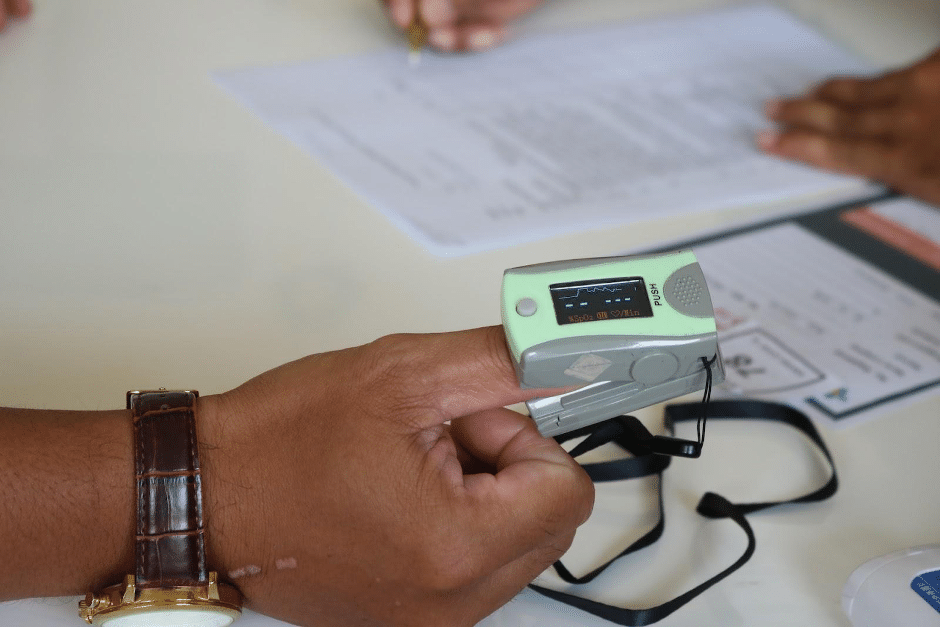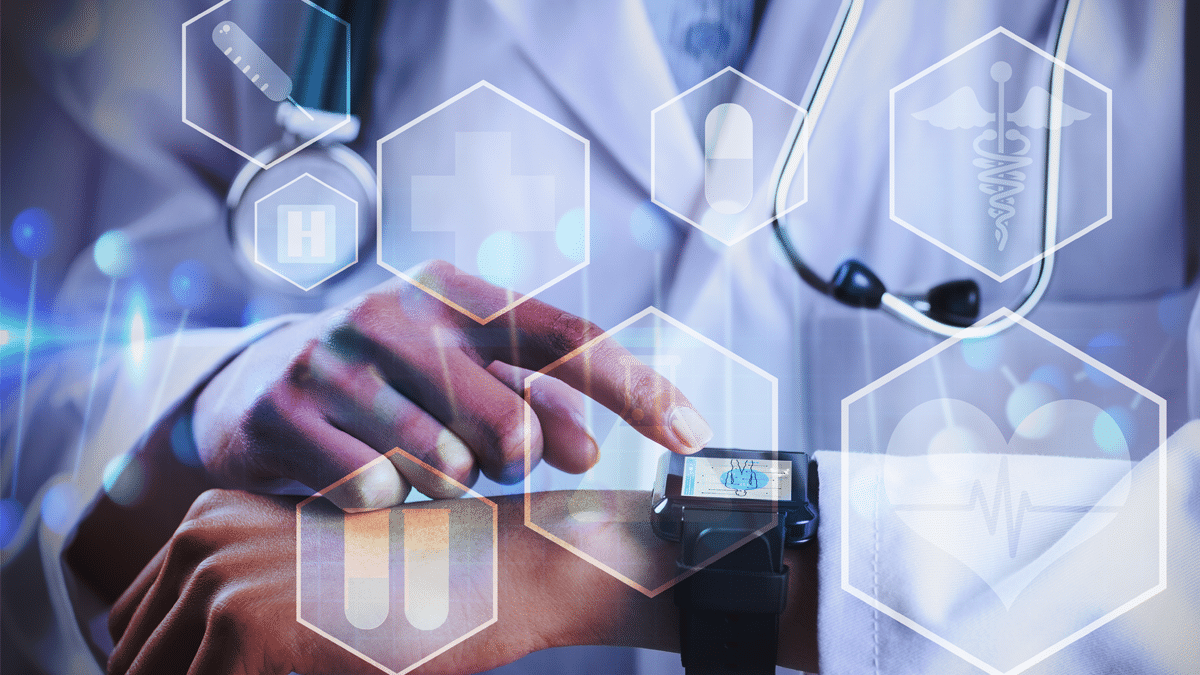The healthcare industry is undergoing a rapid digital transformation, and the Internet of Things (IoT) is playing a significant role in revolutionizing patient care. Referring to Accenture’s survey of 180 Digital Health senior executives from the Pharma and MedTech sectors, the majority of surveyed healthcare practitioners perceive the adoption of digital technologies as part of their growth strategy for the near future. And, in particular, remote patient monitoring devices and diverse fitness wearables are changing care settings, bringing quality healthcare services to people anywhere.
IoT refers to the devices interconnected with each other via the internet, enabling seamless data exchange and communication. Healthcare business owners and medical practitioners are using healthcare IoT solutions to enhance patient care, improve operational efficiency, and optimize resource management. Let’s explore the top 10 IoT in healthcare examples that are significantly improving healthcare services.
Contents
- IoT in remote patient monitoring
- Telemedicine with medical IoT devices
- Medication management with IoT
- IoT in hospital asset and inventory management
- Patient safety and security thanks to IoT
- Emergency handling with IoT medical devices
- Health monitoring and wellness with IoT
- Robotic surgeries
- Smart hospitals
- Remotely connecting ambulances with medical staff
- Conclusion
IoT in remote patient monitoring
Remote patient monitoring is a critical application of IoT healthcare solutions, enabling patients to be monitored remotely from the comfort of their homes. IoT-enabled wearable devices, smart home health hubs, and remote monitoring systems allow healthcare providers to collect real-time data on patients’ vital signs, activities, and symptoms. This data can be analyzed to detect early warning signs of health issues, allowing for timely interventions and reducing hospital readmissions. Remote patient monitoring with the help of IoT technology can help you improve patient outcomes, increase patient satisfaction, and reduce healthcare costs.

Telemedicine with medical IoT devices
Telemedicine solutions have gained significant traction during the COVID-19 pandemic, and IoT is playing a crucial role in enabling virtual healthcare. Medical IoT devices, such as video conferencing tools, remote diagnostic devices, and virtual health platforms, facilitate remote consultations, diagnostics, and treatment. Patients can receive timely medical treatment from the comfort of their homes. Telemedicine using IoT offers benefits like increased access to healthcare in remote areas, cost savings, and improved patient convenience.
Medication management with IoT
IoT is transforming medication management for patients, improving medication adherence and patient safety. Medication errors can lead to life-threatening consequences. The National Library of Medicine claims that in the US, practically every year 7,000 to 9,000 people die because of medication errors.
Such devices as smart pill dispensers, smart inhalers, and medication tracking apps help patients manage their medications effectively. These devices send reminders, dispense medications in the right dosage, and track medication usage. IoT in medication management also helps healthcare providers monitor patient adherence remotely and make timely interventions to ensure medication compliance.
IoT in hospital asset and inventory management
Hospital asset and inventory management can be complex, and IoT is simplifying the process by providing real-time visibility and monitoring. Devices like RFID tags, smart shelves, and tracking systems enable hospitals to track and manage assets and inventory efficiently. These devices help to prevent loss or theft of valuable assets, optimize inventory levels, and reduce waste. Improved operational efficiency, cost savings, and reduced manual efforts are some of the benefits of using IoT in hospital asset and inventory management.
Patient safety and security thanks to IoT
Patient safety is of paramount importance in healthcare, and IoT is playing a significant role in enhancing patient safety and security. For instance, smart patient wristbands, smart beds, and smart alarms are designed to monitor patients’ movements, activities, and behaviors in real time. These devices can alert healthcare providers in case of falls, unauthorized movements, or other potential safety risks.
Additionally, IoT-based security systems with video surveillance, access control, and asset tracking capabilities help to ensure the safety and security of patients, staff, and visitors within healthcare facilities. By leveraging IoT for patient safety and security, healthcare providers can prevent adverse events, reduce patient harm, and enhance overall patient care quality.
Emergency handling with IoT medical devices
Emergency situations require quick and efficient handling, and IoT is providing critical support in emergency care settings. Medical devices like smart defibrillators, smart ambulances, and remote monitoring systems are enabling rapid response and efficient emergency care. These devices can transmit real-time patient data to healthcare providers, allowing for timely diagnosis and treatment decisions.
IoT in emergency handling also helps in optimizing resource allocation, such as routing ambulances to the near available hospitals with appropriate resources. This can significantly improve emergency care outcomes and save valuable time in critical situations.
Health monitoring and wellness with IoT
IoT-enhanced wearable devices, smart scales, and fitness trackers are helping individuals monitor their health and wellness parameters, such as heart rate, sleep patterns, activity levels, and nutrition intake. This data can be shared with healthcare providers for remote monitoring and personalized interventions to support patients in achieving their health goals. IoT in health monitoring and wellness empowers patients to take charge of their health, promotes preventive care, and supports lifestyle modifications for better health outcomes.

Robotic surgeries
Robotic surgeries have gained widespread adoption in healthcare, and IoT is enabling more advanced and precise surgical procedures. IoT-enhanced robotic surgical systems provide real-time feedback, data analytics, and remote control capabilities to surgeons, allowing for highly precise and minimally invasive surgeries.
These systems can transmit data, such as surgical images, to remote locations for real-time consultations and collaborations. Robotic surgeries with IoT are associated with shorter hospital stays, faster recovery times, and reduced complications, leading to improved patient outcomes and quality of care.
Smart hospitals
IoT is transforming traditional hospitals into smart hospitals by integrating various IoT technologies to optimize hospital operations and enhance patient care. Such systems as smart beds, smart lighting, smart HVAC, and energy management systems are designed to improve patient comfort, optimize energy usage, and reduce operational costs.
IoT-based patient tracking systems, real-time location systems (RTLS), and asset management systems help streamline patient flow, optimize resource allocation, and improve patient experience. Smart hospitals and IoT healthcare companies also leverage data analytics and predictive algorithms to optimize patient scheduling, predict patient deterioration, and enhance patient outcomes.
Remotely connecting ambulances with medical staff
Among many IoT applications in healthcare is facilitating seamless communication and connectivity between ambulances and medical staff, enabling efficient remote triaging and decision-making. Ambulance systems, equipped with IoT communication devices, patient monitoring devices, and real-time data transmission capabilities, allow ambulance crews to communicate with healthcare providers in real time.
This enables medical staff to remotely assess patients’ conditions, provide guidance to ambulance crews, and prepare for patients’ arrival at the hospital. This connected ecosystem helps in reducing delays in patient care, optimizing resource allocation, and improving patient outcomes in critical situations.
Conclusion
The adoption of IoT in healthcare is transforming patient care and improving operational efficiency in healthcare settings. From remote patient monitoring to telemedicine, and medication management to smart hospitals and robotics surgeries, IoT is revolutionizing the way healthcare is delivered.
Healthcare practitioners need to keep abreast of the latest IoT technologies and explore opportunities to make use of them for better patient outcomes, improved patient satisfaction, and business efficiency. Embracing IoT in healthcare can lead to a more coordinated and patient-centric healthcare ecosystem. It’s time to harness the power of IoT and unlock its potential in the healthcare industry for a healthier future.

